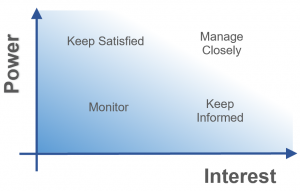
Projects are like trains rolling down the tracks – Once they are put in motion and then they are hard to stop.
Stakeholder communication is one of the project manager’s most important jobs because the stakeholders define the success of a project. The stakeholders must be identified, actively managed, and communicated with to ensure their buy-in to the final product, or you might find yourself on the express to project purgatory.
Stakeholder communication contains 3 Components:
- Stakeholder Identification
- Stakeholder Analysis
- Stakeholder Management
Stakeholder Identification
It can’t be understated that the stakeholders who usually derail a project are the ones who were not identified at the beginning and are hence not adequately communicated with.
Every project has primary stakeholders that everyone knows about, for example the adjacent landowners on a condo project, the database manager in an I.T. project, or the underground utility on a subway project. But it’s the secondary stakeholders who are less well managed who tend to trip up a project.
There are 4 types of project stakeholders:
- Upwards
These are the stakeholders involved with initiating and financing the project. They include the project sponsor, executives from the parent organization, financiers, and investors. They are supportive stakeholders, that is, they want the project to succeed. But they have varying communication requirements to keep them updated. - Downwards
These stakeholders perform the project work. They are the project team, the suppliers and contractors. They wish to be fairly treated and compensated for their work. Also, since projects are temporary endeavors with a defined beginning and end, these stakeholders wish to leave the project in a slightly better position than when they began, for example, with a new reference, or more skills. - Sideways
These are the stakeholders that are in competition for limited resources. Sideways stakeholders can include other project managers, competitors, and organizations. It can also include technical or department managers that lend talent and resources to the project. These stakeholders are supportive of the project but must balance limited resources with their own needs. The project needs to return resources back to the owners in the condition that they were received, and communicate effectively to keep these stakeholders on board. - Outwards
These are the stakeholders who are external to the project and have varying requirements, like adjacent landowners, government regulatory agencies, and so forth. It can even include the general public, for example a road construction project may include the general public as a stakeholder. The requirements of this category are as varied as the category itself, and each stakeholder must be listed and analyzed to ensure their communication needs are being met.
Stakeholder Analysis
 This brings us to stakeholder analysis. If you are to effectively communicate with stakeholders, you need to know what they need and why. This analysis determines what drives the stakeholder, their underlying motivations and needs from the project.
This brings us to stakeholder analysis. If you are to effectively communicate with stakeholders, you need to know what they need and why. This analysis determines what drives the stakeholder, their underlying motivations and needs from the project.
Stakeholder analysis starts with a power-interest matrix. This matrix defines the stakeholder on two perspectives:
- Power is the ability of the stakeholder to force change onto the project, or to stop the project altogether.
- Interest is the amount that the stakeholder is affected by the project, and vice versa. It is size of the overlap between the stakeholder and the project.
A government regulatory permitting agency would be an example of a stakeholder with high power, because they can stop the project with the stroke of a pen. Their interest can be anywhere on the scale, depending on the type of project. Likewise, an adjacent landowner who’s land is being annexed would be a stakeholder with high interest.
 Stakeholders are plotted on the Power-Interest matrix and their location on the chart determines how to manage them.
Stakeholders are plotted on the Power-Interest matrix and their location on the chart determines how to manage them.
- High power, high interest stakeholders are major project stakeholders. They must be closely managed.
- High power, low interest stakeholders must be kept satisfied or they could derail the project over a minor issue.
- Low power, high interest stakeholders must be kept informed so they feel included in the decision making process and don’t exert undue influence to stop it.
- Low power, low interest stakeholders must be monitored to ensure they don’t derail the project.
Following the Power-Interest matrix, each stakeholder is analyzed according to their underlying motivations:
- Financial interests
The stakeholder will make or lose money or income because of the project. - Moral and ethical values
The stakeholder does or does not believe that the project is beneficial to society. - Rights
Legal rights, such as Occupational Health & Safety, affect the stakeholder. - Religious beliefs
The stakeholder’s opinion about the project is based on their religious beliefs. - Political opinions
The political opinions of the stakeholders might cause them to support or resist the project. - Business interests
The stakeholder will realize a change in business revenue as a result of the project. - Knowledge
The level of knowledge a stakeholder has about a project can be a factor in their support or opposition. - Demographics
Age and population characteristics of the stakeholder often affect the support for or resistance against the project. - Environmental stewardship
The stakeholder is supportive or opposed to the project’s environmental footprint. - Value of ownership
The stakeholder will gain or lose value of something they own, for example a property. - Communication preferences
Many projects have seen their success erode merely due to poor communication itself.
To track each stakeholder throughout the project, stakeholders are placed on a scale identifying their support level for the project, in one of five categories:
- Unaware
They are not aware of the project. - Resistant
They are aware of the project but are not supportive of it. - Neutral
They are neither supportive nor opposed to the project. - Supportive
They are in favor of the project. - Leading
They are actively engaged in the project’s success.
Each stakeholder is placed on this scale, for example, with a “C” to designate their current location and a “D” to designate their desired location.
 This is called a stakeholder engagement assessment matrix, and it facilitates tracking the stakeholder’s progress throughout the project. Often stakeholders must be moved from the Unaware and Resistant columns to the Neutral or Supportive column during the course of the project. When this is the case, they require significant planning and resources, and I might add, solid execution of the plan.
This is called a stakeholder engagement assessment matrix, and it facilitates tracking the stakeholder’s progress throughout the project. Often stakeholders must be moved from the Unaware and Resistant columns to the Neutral or Supportive column during the course of the project. When this is the case, they require significant planning and resources, and I might add, solid execution of the plan.
One should not underestimate the resources required to move stakeholders from a resistant status to neutral or supportive. Most projects who have these types of stakeholders must produce reports, make presentations, and hold face to face meetings (and so on) all of which have project schedule and budget implications.
Stakeholder Communication Plan
The communication plan identifies how the stakeholder will be communicated with, the type, frequency, and medium. It establishes the content of the communication and what it intends to accomplish.
Each stakeholder has their own unique needs and must be addressed individually. While it is true that stakeholders fall into groups with similar communication needs, one cannot stop at lumping stakeholders into groups. They must be communicated with on their own terms and given personal attention. Each stakeholder should have a detailed plan that includes the following types of stakeholder communication:
- Phone conversations
- Team meetings
- Presentations
- Notice boards
- Newsletters, magazines or e-magazines
- Letters to staff
- Press releases
- Annual or progress reports
- Emails and intranets
- Web portals
- Focus groups
- Consultation meetings
- Face to face, formal or informal meetings with stakeholders
- Social media
Stakeholder Management
 Throughout the project, each stakeholder is managed to ensure their communication needs are being met. The stakeholder is tracked using information systems to ensure they are adequately moving to their desired place of project buy-in. Not all stakeholders need to be in full approval, but often enough of an acceptance to avoid active opposition is enough.
Throughout the project, each stakeholder is managed to ensure their communication needs are being met. The stakeholder is tracked using information systems to ensure they are adequately moving to their desired place of project buy-in. Not all stakeholders need to be in full approval, but often enough of an acceptance to avoid active opposition is enough.
Stakeholder management throughout the project execution phase consists of the following actions:
- Ensure that the Stakeholder Communications Plan is being followed. If not, take corrective action.
- Assess whether the Stakeholder Communications Plan is still meeting the needs of the project. If not, update it. A review of the actual communications can indicate whether the stakeholder communication needs have changed or new information is received that affects the plan.
Few projects go through their entire life cycle without changes to communication strategies, hence it is important to re-assess the plan regularly.
In project management, the re-evaluation of the plan is called project control. Most project control activities involve making sure the project stays on time and budget (using a technique called earned value analysis), but ensuring the stakeholder communication is still meeting the needs of the project is still an important component.
In the Project Management Body of Knowledge (PMBOK) project control is a separate activity from project execution, although they generally happen simultaneously.






